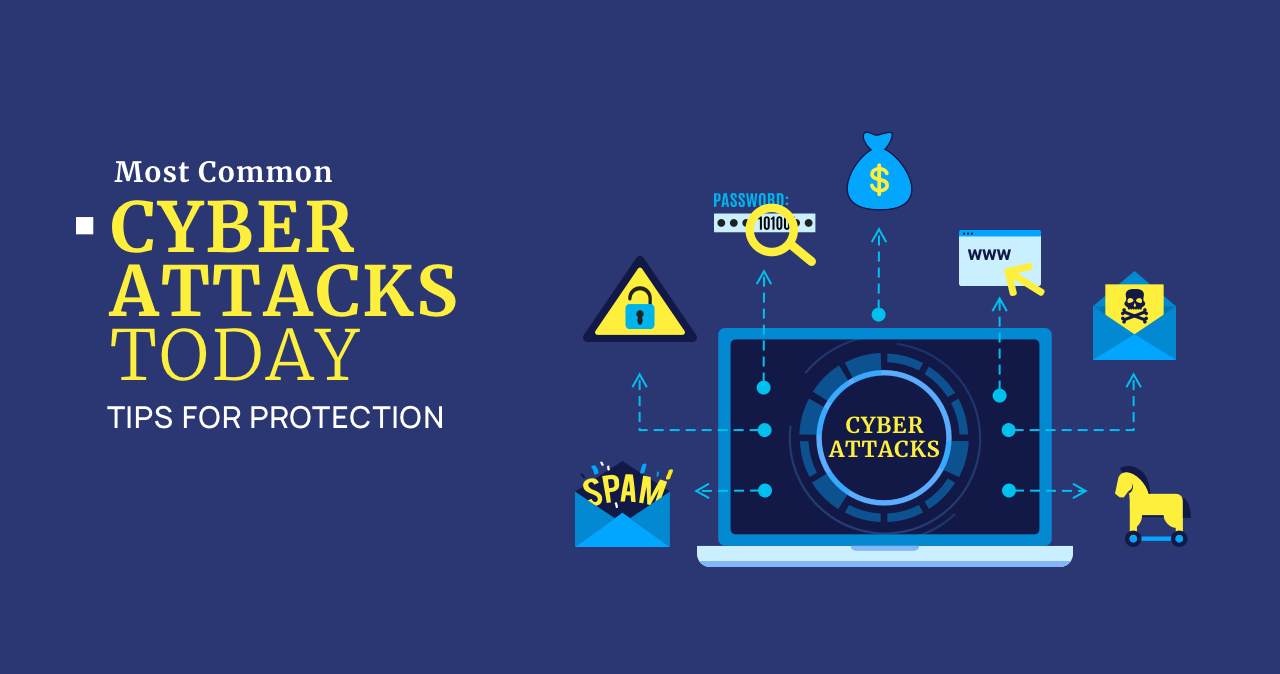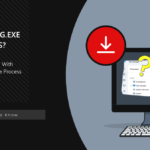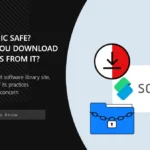Cyber attack technologies have grown increasingly sophisticated, targeting any website where vulnerabilities are present. As a frequent internet user entering personal data, it’s crucial to understand the threats these intrusions pose. Personal data is highly valued by cybercriminals who misuse it for their purposes or even sell it on the dark web.
- 1. Denial-of-Service (DDoS) Attacks
- 2. Man-in-the-Middle (MitM) Attack
- 3. Phishing and Spear-phishing Attacks
- 4. Drive-by Attack
- 5. Password Cyber Attacks
- 6. Adware Cyber Attacks
- 7. Ransomware Cyber Attacks
- 8. Trojan Cyber Attacks
- 9. Spyware Cyber Attacks
- 10. Cryptomining Cyber Attacks
- Protection From Cyber Attacks Today
Cybercrime operates like a vast underground organization capable of collecting, manipulating, and threatening to use stolen data against individuals. This article explores the most prevalent cyber threats today, debunking common cybersecurity myths and providing a detailed list of these threats.
1. Denial-of-Service (DDoS) Attacks
A DDoS attack is a malicious attempt to disrupt normal traffic of a targeted server, service, or network by overwhelming the target or its surrounding infrastructure with a flood of Internet traffic. DDoS attacks achieve effectiveness by utilizing multiple compromised computer systems as sources of attack traffic. These can be exploited computers or other networked resources such as IoT devices. Here are several types of DDoS attacks:
- TCP SYN Flood: The attacker floods the target with TCP “SYN” packets, expecting the server to respond with a “SYN-ACK” response, and then the client will send an “ACK” back to open a connection. The flood of SYN requests causes the target’s system to exhaust resources, rendering it unresponsive to legitimate traffic.
- Teardrop Attack: This attack exploits a vulnerability in the way that operating systems handle packet reassembly from fragments. Maliciously crafted packets are sent in fragments; when the target system tries to reassemble them, it can crash.
- Smurf Attack: The attacker sends a large number of ICMP echo request (ping) packets to network broadcast addresses, all having a spoofed source address of a victim. Consequently, many hosts send echo replies to the victim, overwhelming its network.
- Ping of Death: The attacker sends malicious pings to a computer, typically oversized packets which the target can’t handle, potentially leading to system overload and denial-of-service.
- Botnets: A botnet is a network of computers infected with malicious software and controlled as a group without the owners’ knowledge, e.g., to send spam or participate in a DDoS attack 3. Botnets can target and disable systems, making detection and response difficult.
DDoS Attack Examples:
Understanding these types of attacks and how they function is critical for protecting personal and organizational assets in the digital age. Awareness and proactive cybersecurity measures are essential in mitigating the impact of these threats.
2. Man-in-the-Middle (MitM) Attack
Man-in-the-middle (MitM) attacks intercept and possibly alter the communication between two parties who believe they are directly communicating with each other. One common way to identify if you’re at risk of a MitM attack is by checking the URL of the website you’re visiting. It should start with HTTPS, where the ‘S’ stands for secure, indicating that the data is encrypted. These attacks primarily aim to capture sensitive data during transmission. To protect against this, ensure your website has an SSL (Secure Sockets Layer) certificate, which many hosting providers offer to encrypt data transfers.
MitM Attack Examples:
3. Phishing and Spear-phishing Attacks
Phishing attacks leverage social engineering to deceive users into divulging personal information, such as bank account details and login credentials 4. These attacks often occur via email, where attackers send messages that appear legitimate and relevant to the recipient. To protect yourself, always scrutinize the sender’s email address and the content of the message. If something seems off, it’s safer to mark the email as spam and not interact with it.
Phishing Attack Examples:
4. Drive-by Attack
A drive-by attack involves embedding malicious scripts into the code of websites, often through compromised HTTP or PHP. When a user visits such a site, malware is silently downloaded and installed on their device without the need for interaction. These attacks typically exploit vulnerabilities in outdated or insecure operating systems and browsers. To safeguard against drive-by attacks, it is crucial to keep your software up-to-date and to use robust security practices.
5. Password Cyber Attacks
Passwords are the most common form of authentication in information systems, making them a frequent target of cyber attacks. There are several methods by which attackers can acquire passwords, ranging from simple guessing to sophisticated database breaches. We’ll discuss two primary methods below.
- Brute Force Attacks: This method involves systematically guessing every possible combination of passwords until the correct one is found. Attackers often use knowledge about the target, such as personal interests or significant dates, to make educated guesses. To defend against brute force attacks, it’s crucial to use complex passwords that combine letters, numbers, and symbols, making them difficult to predict.
- Dictionary Attacks: Unlike brute force attacks, dictionary attacks use a list of common passwords and variations. Attackers apply these common passwords to different accounts hoping that one will match. To protect against dictionary attacks, avoid using simple or commonly used passwords. Implementing an account lockout policy that limits the number of failed login attempts can also deter attackers by blocking them after several unsuccessful attempts.
To further enhance security, consider using multifactor authentication (MFA), which requires more than one method of verification to gain account access, significantly reducing the risk of password-based attacks.
6. Adware Cyber Attacks
Adware, often considered merely annoying, can actually be part of a more malicious attack strategy. While adware primarily displays unwanted ads, it can also serve as a gateway for spyware and other malicious software that compromise security and privacy. Adware attacks typically exploit browser vulnerabilities to inject unwanted ads, which can redirect users to harmful sites or trick them into downloading malware.
7. Ransomware Cyber Attacks
Ransomware is a devastating type of cyber attack where malicious software encrypts the victim’s files or locks them out of their device, demanding a ransom to restore access. This attack follows a straightforward yet effective scheme: it encrypts critical data or systems, blocks user access, and demands payment, often with a timer to increase pressure. Protecting against ransomware involves robust backups, updated security patches, and awareness of phishing tactics which often serve as the entry point for these attacks.
8. Trojan Cyber Attacks
Trojans masquerade as legitimate software but perform malicious activities once installed. Unlike viruses, Trojans do not replicate but they pave the way for further infiltration by other malware or expose vulnerabilities. Trojan attacks can lead to data theft, unauthorized access to affected systems, and can act as a backdoor for additional malicious operations. Ensuring software authenticity and avoiding downloads from untrusted sources are key to preventing Trojan attacks.
9. Spyware Cyber Attacks
Spyware is designed to stealthily monitor and collect information from users without their knowledge. This malware type can capture keystrokes, access files, and harvest login credentials and financial information, leading to identity theft and financial fraud. Spyware often infiltrates systems through deceptive links, email attachments, or bundled software installations, emphasizing the need for caution when downloading and installing new software.
10. Cryptomining Cyber Attacks
Malignant cryptominers hijack system resources to mine cryptocurrency, significantly slowing down the infected device and increasing energy consumption. These attacks are typically carried out by embedding malicious scripts into websites or through Trojan downloads. Unlike legitimate mining software, these malicious tools operate without user consent and benefit only the attacker. Users can protect themselves by using web filters and updated antivirus solutions to detect and block cryptomining scripts.
Protection From Cyber Attacks Today
This article has explored a variety of cyber attacks and the forms of malware used to carry them out. Each type of cyber threat we’ve discussed seeks to compromise your device and personal information in some way. However, the goal here is not to deter you from using digital technology, but to arm you with knowledge and solutions to protect against these threats. Modern cybersecurity isn’t about disconnecting from the internet, but about enhancing your defenses to navigate it safely.
We recommend protecting yourself from cybersecurity threats with Gridinsoft Anti-malware. Renowned as one of the best cybersecurity tools available, it offers comprehensive protection by monitoring network activities, encrypting data, and scanning all incoming files to your devices. For those on the fence, consider reading our article to better understand its benefits and capabilities. Equip yourself with a robust cybersecurity solution that is fast, efficient, and effective at maintaining your digital safety.
- Signs that your computer is part of a botnet.
- Most Common Types of Social Engineering Attacks.
- Signs that your computer is part of a botnet.
- Most Common Types of Social Engineering Attacks.





